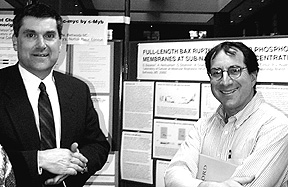
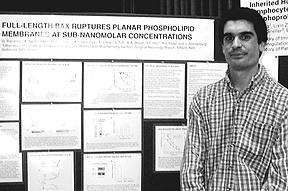
| T H E N I H C A T A L Y S T | M A Y - J U N E 2000 |
|
|
|
ALL'S FARE IN (CELL) LIFE AND DEATH |
text and photos
|
 |
|
WALS
lecturer Craig Thompson (left) and NICHD's Josh Zimmerberg, mentor to
FARE winner Gorka Basanez (below)
|
 |
|
Gorka
Basanez demonstrates how "Full-Length Bax Ruptures Planar Phospholipid
Membranes at Subnanomolar Concentrations."
|
There were 130 winners in the fifth annual FARE (Fellows Award for Research Excellence, 1999) competition, and the NIH community has been having the opportunity to view these FAREST of them all each Wednesday when, in conjunction with the Wednesday Afternoon Lectures, sets of related winning posters are on display outside the Visitor’s Information Center in Building 10, a few feet away from the doors to Masur Auditorium, where the lecture takes place.
The lectures and posters will continue through June 30. Following are descriptions of the FARE wares of Wednesday, April 14.
Five of the winners presented posters of their work related to the talk (sponsored by the Apoptosis and Cell Biology Interest Groups) given by Craig Thompson of the University of Chicago on "Keeping Cells Alive: Is Caspase Inhibition Enough?" Certain extracellular signals activate intracellular proteins that regulate the process of cell death. In his talk, Thompson highlighted the role of mitochondria in apoptosis, or programmed cell death. One of the Bcl-2 family of proteins, Bcl-xL, appears to form a pore in the outer membrane of the mitochondria.
This leads to loss of membrane potential and influences activation of the caspase enzymes, which ultimately mediate apoptosis.
How signals through cell surface receptors influence the bioenergetics of a cell remains a complex issue in the study of apoptosis.
The posters described research of both positive and negative signals leading to cellular apoptosis or activation. The work by Gorka Basanez, conducted in the NICHD Laboratory of Cellular and Molecular Biophysics with Josh Zimmerberg, corroborated Thompson’s talk by demonstrating the effect of the protein Bax on mitochondrial membrane stability.
"We studied pore formation by Bax and found that the pore is partially composed of lipid—it’s not purely protein," Basanez said, noting that full-length Bax caused conductance changes that led to rupture of planar phospholipid membranes at very low protein concentrations.
This work implies that Bax may act directly on mitochondrial membranes, said Basanez, who intends to continue in basic research in either the United States or his native Spain.
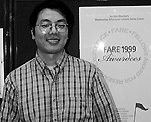 |
|
Jim
Wang elaborates on the "Inherited Caspase-10 Mutation in the Human
Autoimmune-Lymphoproliferative System."
|
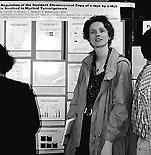 |
|
Martina
Schmidt elucidates how the "Regulation of the Resident Chromosomal
Copy of c-myc
by c-Myb Is Involved in Myeloid Tumorigenesis."
|
Defects in the apoptotic signal cascade can have clinical manifestations, and Jin Wang, who generally can be found in Mike Lenardo’s lab in the NIAID Laboratory of Immunology, showed that a mutation within caspase 10 disrupts lymphocyte apoptosis and provides an explanation for some cases of autoimmune lymphoproliferative syndrome.
His exposure as a FARE recipient, Wang said, has expanded his contacts and opportunities to discuss his research with NIH colleagues. In an otherwise normal day, he said, "Not many people come to the 11th floor" (of the Clinical Center).
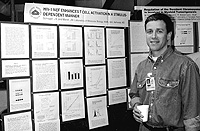 |
|
Jeffrey
Schrager explains how "HIV-1 Nef Enhances T-Cell Activation in a
Stimulus-Dependent Manner."
|
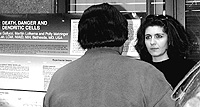 |
|
Stefania
Gallucci unfolds the drama of "Death,
Danger, and Dendritic Cells."
|
Martina Schmidt, whose research was conducted with Linda Wolff in the NCI Laboratory of Cellular Oncology, demonstrated for the first time that inappropriate regulation of a transcriptional activator called Myb can disregulate the chromosomal copy of the Myc gene and enhance cellular proliferation.
Schmidt said she wants to continue studying other genes activated by Myb that are involved in myeloid tumor formation.
A similar stimulatory relationship akin to that in Schmidt’s laboratory exists between activated cells and HIV in Jeff Schrager’s research world. From his base in the NIMH Laboratory of Molecular Biology, with Jon Marsh, Schrager showed that the HIV protein called Nef lowers the threshold for activation in T-cells and allows enhanced replication of the virus.
Without Nef, HIV replication is diminished, and infection would not progress to AIDS.
Schrager used his FARE travel award to present his work at the AIDS Pathogenesis Keystone meeting in January. Come the fall, he’ll be moving from NIMH to NCI for pathology training.
Stefania Gallucci’s work in NIAID provides initial evidence to support the "Danger Model," which predicts that damaged or necrotic tissue sends an alarm to activate the immune response.
Programmed cell death provides a means to delete cells without activating the immune response, and Gallucci found that dendritic cells become activated only after incubation with necrotic fibroblasts, not with apoptotic cells.
Gallucci works in Polly Matzinger’s lab in NIAID’s Laboratory of Cellular and Molecular Immunology—also known as the "Ghost Lab," she said. Her award for the research done there, however, is far more visible and has given her "recognition that I’m doing a good job—not only from my boss but from other postdocs."
These five, like all 130 FARE winners are presenting their research at meetings—with travel travel support from their $1000 FARE travel awards. Twenty percent of applicants were winners in the 1999 competition; next year the percentage will be upped to 25 percent.